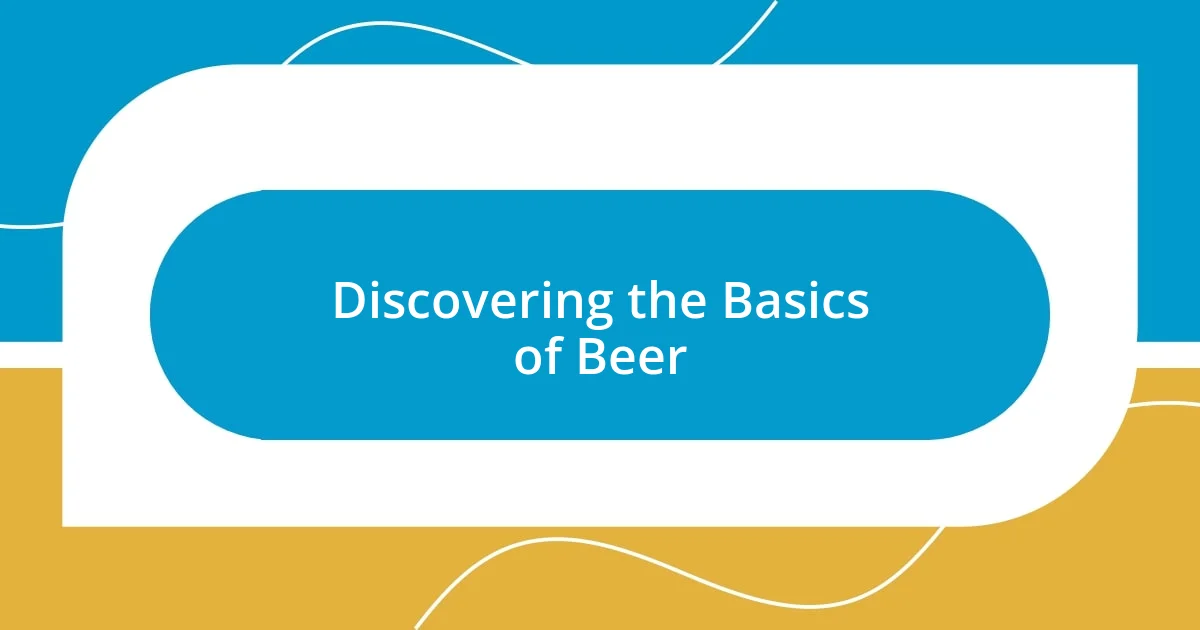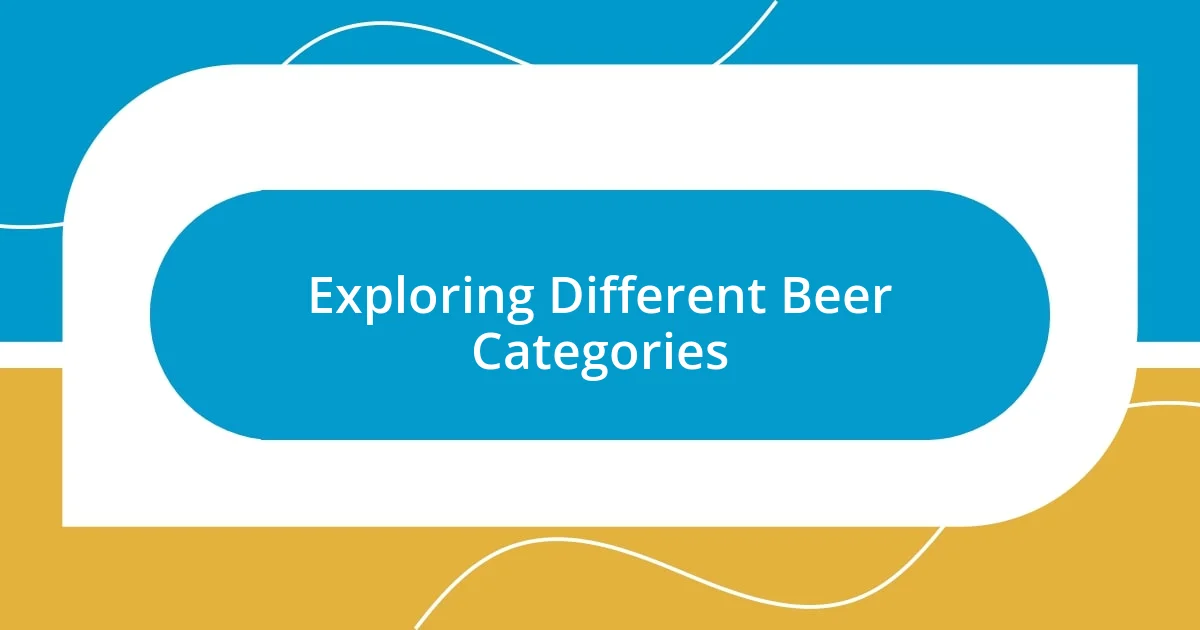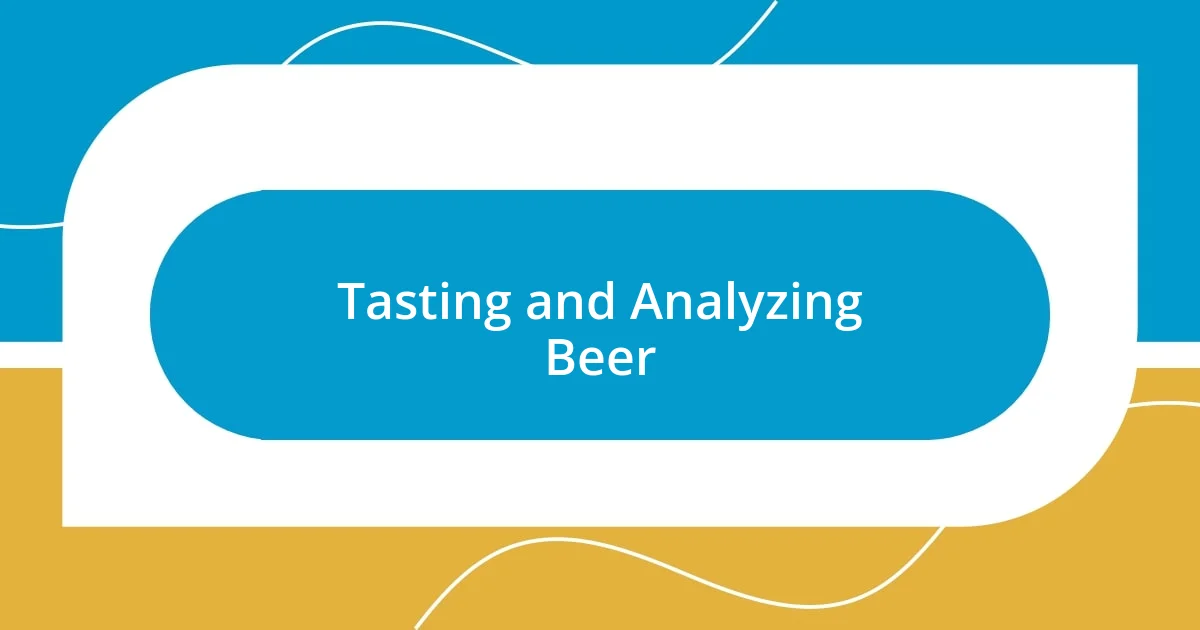Key takeaways:
- Exploring beer styles enhances tasting experiences and fosters connections within the global beer community.
- Understanding key elements such as malt, hops, yeast, and water is essential for appreciating the diversity of beer flavors.
- Engaging with the beer community and continuously seeking knowledge through resources like books, podcasts, and brewery visits enriches the learning journey.

Introduction to Beer Styles
Beer styles represent a fascinating world filled with diverse flavors and traditions. Each style tells a story about its origins, ingredients, and brewing techniques. I remember my first encounter with a crisp Pilsner; the refreshing bite made me appreciate how much variety exists within something as simple as beer.
Delving into the intricacies of beer styles is like embarking on a journey around the globe. Have you ever wondered how a Belgian Dubbel could bring out rich caramel notes while an IPA bursts with hoppy bitterness? My exploration truly began when I visited a local brewery and discovered the craft of brewing. It was here that I learned how different yeast strains can radically change a beer’s character, sparking my curiosity even further.
Understanding beer styles not only enhances your tasting experience but also connects you to a global community of enthusiasts and brewers. As I’ve shared my newfound knowledge, I’ve felt an inviting camaraderie among fellow beer lovers, each with stories and preferences reflecting their unique experiences. Isn’t it incredible how something as humble as a pint can bridge perspectives and create lasting friendships?

Discovering the Basics of Beer
When I first started exploring the basics of beer, I found the sheer variety of styles somewhat overwhelming. Each type carries its own history and character. I recall my surprise tasting a rich stout that felt like a warm hug on a chilly evening; the dark coffee and chocolate notes were unlike anything I had expected. It was those moments that ignited an enthusiasm in me to learn more.
To grasp the fundamentals of beer, it helps to focus on a few key elements:
- Malt: This is what provides the sugars necessary for fermentation and gives the beer its color and sweetness.
- Hops: These flowers add bitterness to balance the malt’s sweetness and contribute to aroma and flavor.
- Yeast: Essential for fermentation, different strains can produce varying tastes and aromas in a beer.
- Water: Often overlooked, but the mineral content can significantly impact the beer’s final flavor.
- Style Characteristics: Understanding various styles, from lagers to ales, allows you to appreciate the subtle differences.
Learning about these basics has made each tasting more exciting and educational. What I love most is how these elements come together to tell a story in every sip.

Exploring Different Beer Categories
When I began my journey into beer, I discovered that exploring different beer categories was like diving into a treasure chest of flavors. Each category, whether it be lager, ale, or stout, offers a unique experience. I still vividly recall sipping on a rich, creamy milk stout for the first time. It had this luxurious mouthfeel that felt almost decadent, leading me to appreciate how delightful and varied beer can truly be.
As I navigated through various beer styles, I found myself fascinated by the historical and cultural contexts behind each category. For example, have you ever tried a sour beer? The tartness reminded me of summer days, while the complex blend of flavors made each sip feel like a delightful surprise. I remember enjoying a Berliner Weisse during a sunny afternoon picnic; it was light, refreshing, and the perfect complement to the warm weather. These experiences illustrate the incredible range found within beer categories.
With so many styles to explore, it can be a bit daunting at first. I often recommend starting with a flight at a local brewery. This allows you to sample a range of styles side by side. It’s a fantastic way to hone your palate and discover what resonates with you personally. Each category can elevate a simple gathering into a mosaic of experiences, enhancing the social aspect of beer.
| Beer Category | Typical Flavor Profile |
|---|---|
| Lager | Crisp, clean, and often light-bodied |
| Ale | Varied profiles; generally fruity or estery |
| Stout | Rich, dark, with flavors of chocolate and coffee |
| Sour Beer | Tart, tangy, with complex fruit notes |

Tasting and Analyzing Beer
When it comes to tasting and analyzing beer, I’ve learned that engaging all of your senses truly enhances the experience. Have you ever taken a moment to just look at a beer? The color and clarity can tell a lot about what’s inside. I remember the first time I poured a bright, golden pilsner; the way the light danced through it was mesmerizing. It made me curious about what flavors awaited me.
Taking a sip isn’t just about quenching thirst; it’s a careful choreography of flavors. I like to let the beer linger on my palate, allowing the different tastes to unfold. For example, when I sampled a double IPA, the intense grapefruit notes were followed by a subtle pine aftertaste. It was like tasting a forest after a rain shower—a moment I won’t forget. Reflecting on these layers while drinking strengthens my appreciation for the craft behind each brew.
I also find it rewarding to jot down my thoughts after each tasting. This helps me keep track of what I love and what I’d like to explore further. Have you ever experienced a beer that evoked a specific memory or place? The other day, I enjoyed a smoky porter that transported me back to camping trips around a campfire. It’s fascinating how a single sip can trigger such rich emotions, deepening the connection I have with beer and the stories it tells.

Learning from Beer Resources
When I started diving into beer resources, I found a wealth of knowledge at my fingertips. Books like “The Brewer’s Tale” by Matt Camby opened my eyes to the stories behind different brews. I remember curling up with it on a rainy afternoon, completely enthralled by the tales of historic breweries and how they shaped beer culture. Each page was like a portal to different times and places, helping me appreciate the craft even more deeply.
Podcasts also became a game changer for my self-education. Listening to seasoned brewers and beer enthusiasts share their insights was like having a conversation with friends who just couldn’t wait to share their favorite tips. I recall a particularly engaging episode where a guest detailed the nuances between various Belgian styles. The way they described the intricate flavors made me rush to my local store to seek out a classic Tripel. It’s those personal stories and discussions that resonate, turning seemingly simple topics into fascinating explorations.
Of course, visiting breweries and participating in tastings brought my learning full circle. I remember a guided tour where the brewer passionately explained the brewing process, while we sampled fresh beer right from the tank. It was enlightening and incredibly satisfying to taste the difference that freshness makes. Engaging directly with the makers not only boosted my understanding but also created a sense of connection; I wasn’t just drinking beer—I was experiencing the art behind it. How could anyone not feel inspired by that?

Engaging with the Beer Community
Engaging with the beer community is an experience that has truly enriched my journey. I vividly remember my first local beer festival; the atmosphere was electric. People gathered around, enthusiastically sharing their favorite brews, and I found myself swapping tasting notes with complete strangers. Have you ever felt that moment when a shared passion creates an instant bond? It’s incredible how beer can bring people together, making you feel part of something larger.
I’ve also delved into online forums and social media groups dedicated to beer enthusiasts. It was there that I discovered a treasure trove of information—everything from homebrewing tips to the latest craft beer releases. One evening, I stumbled upon a thread discussing barrel-aged beers. The passion and knowledge displayed by other members opened my eyes to a new world of flavors. Engaging in discussions and asking questions made me feel like I was part of a vibrant, supportive family. Isn’t it amazing how technology can connect us with others who share our interests?
Volunteering at local beer tastings and events has offered a hands-on approach to learning as well. I remember pouring samples at a charity event, and each interaction taught me something new. Guests would excitedly describe their favorite beer styles, often sharing personal stories about what those beers meant to them. These encounters deepened my appreciation for the community around beer—it’s not just about the drinks, but also about the stories that come with them. Have you ever felt that each beer could tell you a story? I certainly have, and it makes every sip feel special.

Continuing Education on Beer Styles
Continuing my education on beer styles means constantly seeking out new experiences and knowledge. I recall a trip I took to Belgium, where I visited several small breweries tucked away in charming villages. Speaking with the brewers, I learned about unique ingredients they used and traditional methods passed down through generations. What struck me most was the sheer passion they exuded; it was contagious. How often do we encounter such dedication in our own everyday lives?
Webinars and online courses have also played a significant role in my continued learning. I took one that focused on beer tasting techniques, which opened my palate to nuances I never noticed before. It was a revelation to understand how temperature and glass shape can influence a beer’s flavor profile. Have you ever seen a light bulb go off in someone’s eyes when they taste their first IPA properly? It’s those moments that drive my ambition to learn more and share that knowledge with others.
Finally, I always prioritize reading industry blogs and reviews from beer critics; they often provide fresh insights into styles I might not have considered exploring. Just the other day, I stumbled upon a blog post analyzing sour beers, and their infectious enthusiasm made me prioritize a visit to a nearby brewery that specializes in that style. Isn’t it empowering to step outside your comfort zone and try something new? Each fresh experience reinforces my journey of education, continuously shaping my understanding and appreciation of the ever-expanding world of beer.














